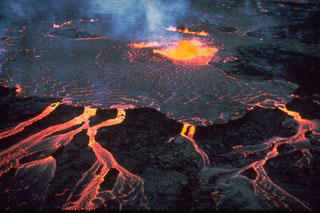Report on Kilauea (United States) — 15 August-21 August 2007
Smithsonian Institution / US Geological Survey
Weekly Volcanic Activity Report, 15 August-21 August 2007
Managing Editor: Sally Sennert.
Please cite this report as:
Global Volcanism Program, 2007. Report on Kilauea (United States) (Sennert, S, ed.). Weekly Volcanic Activity Report, 15 August-21 August 2007. Smithsonian Institution and US Geological Survey.
Kilauea
United States
19.421°N, 155.287°W; summit elev. 1222 m
All times are local (unless otherwise noted)
HVO reported that fissure segment D from Kilauea's 21 July fissure eruption continued to feed an advancing 'a'a lava flow during 15-21 August. Aerial observations on 17 August revealed that the first 'a'a flow had advanced 24 m since 13 August but was inactive. The second 'a'a channel had advanced 2.3 km along the N side of the first flow. Smoke from burning vegetation was visible near the flow front. On 18 August, a new and widening crack was seen on the rim of Pu'u 'O'o crater. A few small earthquakes were located beneath the summit, Halema'uma'u crater, and the S flank.
On 14 August, approximately 17.8 hectares (44 acres) of the East Lae'apuki bench collapsed, possibly due to a M 5.4 earthquake, high surf from hurricane Flossie, or a combination of both.
Geological Summary. Kilauea overlaps the E flank of the massive Mauna Loa shield volcano in the island of Hawaii. Eruptions are prominent in Polynesian legends; written documentation since 1820 records frequent summit and flank lava flow eruptions interspersed with periods of long-term lava lake activity at Halemaumau crater in the summit caldera until 1924. The 3 x 5 km caldera was formed in several stages about 1,500 years ago and during the 18th century; eruptions have also originated from the lengthy East and Southwest rift zones, which extend to the ocean in both directions. About 90% of the surface of the basaltic shield volcano is formed of lava flows less than about 1,100 years old; 70% of the surface is younger than 600 years. The long-term eruption from the East rift zone between 1983 and 2018 produced lava flows covering more than 100 km2, destroyed hundreds of houses, and added new coastline.
Source: US Geological Survey Hawaiian Volcano Observatory (HVO)

